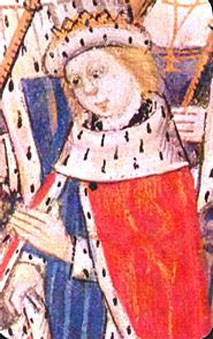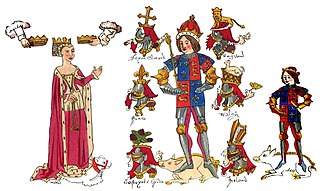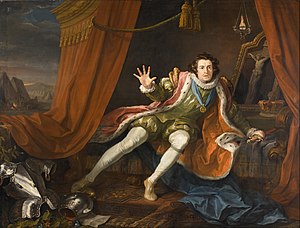
The Battle of Bosworth or Bosworth Field was the last significant battle of the Wars of the Roses, the civil war between the houses of Lancaster and York that extended across England in the latter half of the 15th century. Fought on 22 August 1485, the battle was won by an alliance of Lancastrians and disaffected Yorkists. Their leader Henry Tudor, Earl of Richmond, became the first English monarch of the Tudor dynasty by his victory and subsequent marriage to a Yorkist princess. His opponent Richard III, the last king of the House of York, was killed during the battle, the last English monarch to fall in battle. Historians consider Bosworth Field to mark the end of the Plantagenet dynasty, making it one of the defining moments of English history.

Edward V was King of England from 9 April to 25 June 1483. He succeeded his father, Edward IV, upon the latter's death. Edward V was never crowned, and his brief reign was dominated by the influence of his uncle and Lord Protector, the Duke of Gloucester, who deposed him to reign as King Richard III; this was confirmed by the Titulus Regius, an Act of Parliament which denounced any further claims through Edward IV's heirs by delegitimising Edward V and all of his siblings. This was later repealed by Henry VII, who wished to legitimise his reign by marrying Elizabeth of York, Edward V's eldest sister.

The Tragedy of Richard the Third, often shortened to Richard III, is a play by William Shakespeare. It was probably written c. 1592–1594. It is labelled a history in the First Folio, and is usually considered one, but it is sometimes called a tragedy, as in the quarto edition. Richard III concludes Shakespeare's first tetralogy, and depicts the Machiavellian rise to power and subsequent short reign of King Richard III of England.

Henry VI, Part 3 is a history play by William Shakespeare believed to have been written in 1591 and set during the lifetime of King Henry VI of England. Whereas 1 Henry VI deals with the loss of England's French territories and the political machinations leading up to the Wars of the Roses and 2 Henry VI focuses on the King's inability to quell the bickering of his nobles, and the inevitability of armed conflict, 3 Henry VI deals primarily with the horrors of that conflict, with the once stable nation thrown into chaos and barbarism as families break down and moral codes are subverted in the pursuit of revenge and power.

In the First Folio, the plays of William Shakespeare were grouped into three categories: comedies, histories, and tragedies. The histories—along with those of contemporary Renaissance playwrights—help define the genre of history plays. The Shakespearean histories are biographies of English kings of the previous four centuries and include the standalones King John, Edward III and Henry VIII as well as a continuous sequence of eight plays. These last are considered to have been composed in two cycles. The so-called first tetralogy, apparently written in the early 1590s, covers the Wars of the Roses saga and includes Henry VI, Parts I, II & III and Richard III. The second tetralogy, finished in 1599 and including Richard II, Henry IV, Parts I & II and Henry V, is frequently called the Henriad after its protagonist Prince Hal, the future Henry V.

Ricardians are people who dispute the negative posthumous reputation of King Richard III of England. Richard III has long been portrayed unfavourably, most notably in Shakespeare's play Richard III, in which he is portrayed as murdering his 12-year-old nephew Edward V to secure the English throne for himself. Ricardians believe these portrayals are false and politically motivated by Tudor propaganda.

Richard III is a 1955 British Technicolor film adaptation of William Shakespeare's historical play of the same name, also incorporating elements from his Henry VI, Part 3. It was directed and produced by Laurence Olivier, who also played the lead role. Featuring many noted Shakespearean actors, including a quartet of knights, the film depicts Richard plotting and conspiring to grasp the throne from his brother King Edward IV, played by Sir Cedric Hardwicke. In the process, many are killed and betrayed, with Richard's evil leading to his own downfall. The prologue of the film states that history without its legends would be "a dry matter indeed", implicitly admitting to the artistic licence that Shakespeare applied to the events of the time.

The Tudor myth is the tradition in English history, historiography and literature that presents the 15th century, including the Wars of the Roses, in England as a dark age of anarchy and bloodshed. The narrative that the Tudor myth perpetrated was curated with the political purpose of promoting the Tudor period of the 16th century as a golden age of peace, law, order, and prosperity. The hope was to elevate King Henry VII's rulership compared to his predecessors.

"The Foretelling" is the first episode of the BBC sitcom The Black Adder, the first series of the long-running comedy programme Blackadder. It marks Rowan Atkinson's debut as the character Edmund Blackadder, and is the first appearance of the recurring characters Baldrick and Percy. The comedy actor Peter Cook guest stars as King Richard III.

Henry VII of England has been depicted a number of times in popular culture.

John of England has been portrayed many times in fiction, generally reflecting the overwhelmingly negative view of his reputation.

Richard II of England has been depicted in popular culture a number of times.
Edward IV of England has been depicted in popular culture a number of times.
Edward VI of England has been depicted in popular culture a number of times.
Henry IV of England has been depicted in popular culture a number of times.
Henry V of England has been depicted in popular culture a number of times.

The Wars of the Roses was a 1963 theatrical adaptation of William Shakespeare's first historical tetralogy, which deals with the conflict between the House of Lancaster and the House of York over the throne of England, a conflict known as the Wars of the Roses. The plays were adapted by John Barton, and directed by Barton and Peter Hall at the Royal Shakespeare Theatre. The production starred David Warner as Henry VI, Peggy Ashcroft as Margaret of Anjou, Donald Sinden as the Duke of York, Paul Hardwick as the Duke of Gloucester, Janet Suzman as Joan la Pucelle, Brewster Mason as the Earl of Warwick, Roy Dotrice as Edward IV, Susan Engel as Queen Elizabeth and Ian Holm as Richard III.
The Hollow Crown is a series of British television film adaptations of William Shakespeare's history plays.
"Henry VI, Part 1" is first episode of the second series of the British television series The Hollow Crown, based on the plays Henry VI, Part 1 and Henry VI, Part 2 by William Shakespeare. The episode was produced by Rupert Ryle-Hodges and directed by Dominic Cooke, who also adapted the screenplay with Ben Power. It starred Tom Sturridge as Henry VI, Sophie Okonedo as Queen Margaret and Adrian Dunbar as Richard of York. The adaptation presents Henry VI in two parts, incorporating all three Henry VI plays. It was first broadcast on 7 May 2016 on BBC Two.
"Henry VI, Part 2" is second episode of the second series of the British television series The Hollow Crown, based on the plays Henry VI, Part 2 and Henry VI, Part 3 by William Shakespeare. It was directed by Dominic Cooke, who also adapted the screenplay with Ben Power. It starred Tom Sturridge as Henry VI, Sophie Okonedo as Queen Margaret and Benedict Cumberbatch as Richard. The adaptation presents Henry VI in two parts, incorporating all three Henry VI plays. It was first broadcast on 14 May 2016 on BBC Two.


















